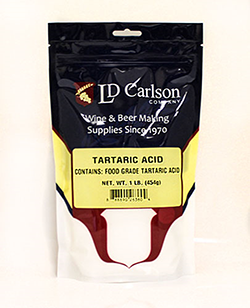The Value of Individual Powdered Acids to Adjust Wine Acidity
Posted by Matteo Lahm on 30th Oct 2023
Let's dive into the fascinating role individual powdered acids can play in your winemaking process. Acidity is the structural foundation in your favorite bottle of wine, providing balance, enhancing flavor, and preserving freshness. Not only do winemakers often need to adjust acidity levels, they need to adjust specific acids to create that perfect sip. Let's find out why.
The importance of acidity in wine cannot be overstated. Low acidity will leave your dry wines tasting flat, lacking the vibrancy and liveliness that make a wine enjoyable. In the case of sweet and semisweet wines, low acidity will overwhelm your palate with sugar because sweetness needs to be balanced by tartness.
This is where the magic of acid powders comes into play. These are not just simple additives like sulfites or fining agents, they are essential tools that actually contribute to a wine’s flavor profile. Acid powders, such as tartaric, malic, and citric acid, are used to fine-tune the acidity in a wine. They allow winemakers to increase the acidity in a controlled manner, ensuring that the wine achieves an optimal balance of flavors.
By adjusting the acidity, winemakers can enhance the wine's inherent characteristics, bringing out the best in the grape's flavor profile. The right acidity can make the fruit flavors in a wine more nuanced, highlight its minerality, and even affect its color and aging potential. So, the next time you savor a glass of perfectly balanced wine, remember the crucial role that acid powders play in creating that harmonious symphony of flavors on your palate.
Now, you might be wondering why shouldn’t you use just use an acid blend that contains tartaric, malic, and citric acid. In cases of fruits that are just low in overall acidity, you can start off with the blend. However, each of these acids plays a unique role in the flavor profile, and sometimes, a winemaker might need to increase one specific acid.
While pH meters are an invaluable tool in the winemaking process, providing a snapshot of the overall acidity of the grape juice, they don't tell the whole story. To delve deeper into the specific levels of individual acids such as tartaric, malic, and citric acid, more specialized equipment, like a spectrophotometer, is required. This allows winemakers to fine-tune the balance of acids in their wine with precision, but they can be expensive. So, if you don’t have one and you can only measure overall pH and total acidity, a good rule of thumb is to begin with an acid blend if the overall acidity is low. This will help bring your wine to a pH of at least 3.6, a level necessary for proper fermentation. Once fermentation is complete, the fine-tuning begins. At this stage, your palate becomes the most important tool. By tasting your wine, you can decide which acids you want to emphasize to increase the acidity slightly and refine the flavor profile, creating a wine that is not only well-balanced but also uniquely yours.
Let’s look at the individual acids and their flavor profiles.
Tartaric acid, often referred to as the "principal acid" in wine, plays a significant role in shaping the taste and stability of your favorite vino. This acid is responsible for the wine's underlying structure, providing a backbone that supports and enhances the beverage's other flavors. In warmer climates, grapes often struggle to develop sufficient natural acidity due to the intense heat, which can lead to wines that lack balance and taste overly sweet or flat. To counteract this, winemakers frequently add tartaric acid, which helps to increase the wine's overall acidity and maintain a balanced flavor profile.

Malic acid, meanwhile, is the acid that gives green apples their distinctive tart flavor. This acid is particularly crucial in cooler climates, where grapes can naturally retain higher levels of malic acid. The cooler temperatures slow down the grape's ripening process, allowing the fruit to maintain higher acidity levels, which contributes to a wine's crispness. By adding malic acid, winemakers can enhance this crispness even further, resulting in a wine with a refreshing, clean finish that's often associated with white wines.
Citric acid, while less commonly used in winemaking, still has its place in the winemaker's toolkit. This acid is primarily used as a preservative, helping to protect the wine from spoilage by bacteria and oxidation. It's also used to enhance the wine's aromatic profile, adding a burst of citrusy freshness that can lift and brighten the overall flavor. However, winemakers must use citric acid sparingly, as too much can lead to a wine that tastes overly sharp or sour. In small amounts, though, it can add an extra dimension of flavor and complexity to the wine.
So, are certain types of acid better suited for different types of wine? Absolutely! For instance, tartaric acid is often used in red wines to enhance their robust flavor, while malic acid is a popular choice for white wines to boost their crispness. If you are making a fruit wine, you might want to find out what the dominant acid is to enhance the characteristic flavor of that fruit.
When you taste your wine after fermentation, you can get a sense of what flavors are lacking and choose to increase the acidity accordingly. Just know that caution is needed. When you get to those final increments, it is always better to add less and inch your way towards your goal. It is easy to add acid but hard to get it out. The use of acid powders in winemaking is a delicate art, a science, and a testament to the winemaker's skill. So next time you enjoy a glass of wine, take a moment to appreciate the balance and complexity that these acids bring to your palate. Cheers to your next flavorful adventure in the world of wines!


